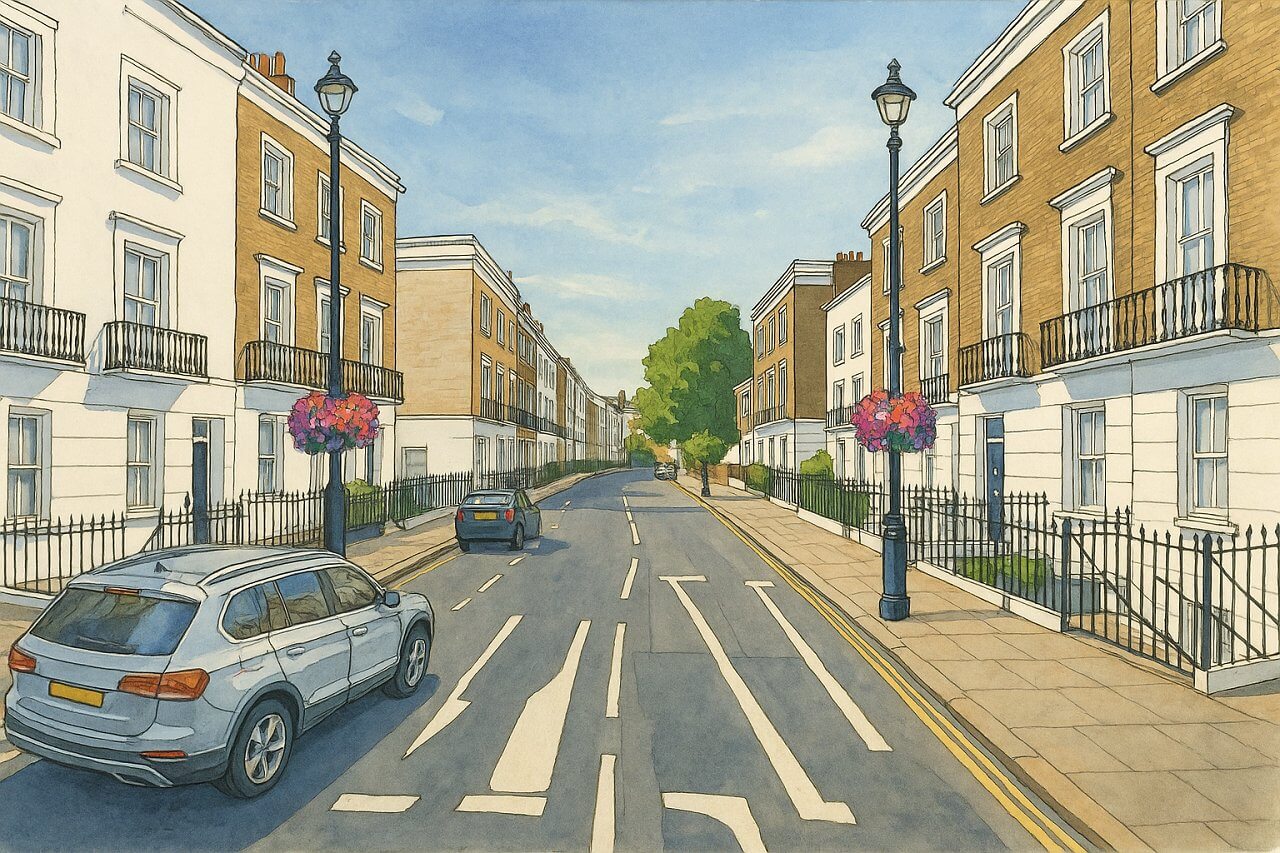
Warwick Way, London
Where Victoria meets Pimlico: a historic thoroughfare with residential charm and convenient access to central London.
Warwick Way is a street located in the City of Westminster, central London. It runs in a southwest to northeast direction, connecting Vauxhall Bridge Road to the northeast with a small roundabout at the junction of Ebury Bridge and Sutherland Street in the southwest. The road forms a natural boundary between two prominent districts—Victoria to the north and Pimlico to the south.
The street lies just a few minutes’ walk from key locations such as Victoria Station, Eccleston Square, and the Pimlico Grid. Despite its central location, Warwick Way retains a calm and residential feel compared to the busy thoroughfares that surround it.
Length and Layout
Warwick Way is approximately 0.4 miles (0.64 km) in length. It is a two-way road for most of its course, lined with a mix of low-rise period buildings, small hotels, shops, and private homes. The street has several side turnings, including Belgrave Road, Cambridge Street, and Alderney Street, contributing to its neighbourhood feel.
History of Warwick Way
Warwick Way was developed in the mid-to-late 19th century, during the great expansion of Pimlico and Victoria as desirable residential districts. This period saw the transformation of marshy land south of Westminster into elegant grid-style streets laid out by the influential developer Thomas Cubitt, who was also responsible for much of Belgravia and Pimlico.
The street originally served as a key residential and service road, accommodating housing for both the upper-middle class and the domestic staff that supported the wealthier homes of nearby Belgravia. Over time, it has remained residential in character but now includes a greater mix of shops, short-let accommodations, and small hotels.
Origin of the Name
Warwick Way is named after the Earls of Warwick, a title in the English peerage. This naming convention follows the pattern found throughout Pimlico and Victoria, where many streets were named after titled nobility or counties, reinforcing the area’s upper-class aspirations during its original development.
The name likely dates from the original development of the area in the 1800s, part of the coordinated urban planning led by the Grosvenor Estate and other aristocratic landowners in London.
Character of the Street
Warwick Way is a residentially oriented street with a balanced mix of local businesses and hospitality services. Much of the housing stock consists of Victorian and Edwardian terraced houses, often subdivided into flats. There is a variety of small cafés, corner shops, newsagents, and independent stores that give the street a local village feel, particularly in contrast to nearby Victoria Street’s corporate character.
There is also a notable presence of budget hotels and bed-and-breakfasts on the street, serving tourists seeking more affordable options close to central London. Despite this mix, Warwick Way remains quieter than surrounding roads, making it an attractive choice for residents.
Streets connected to Warwick Way
- Alderney Street
- Belgrave Road
- Cambridge Street
- Clarendon Street
- Cumberland Street
- Denbigh Street
- Ebury Bridge
- Eccleston Square Mews
- St George's Drive
- Sutherland Street
- Vauxhall Bridge Road
- Warwick Place North
- West Warwick Place
Real Estate and Property Prices
As of May 2025, the average asking price for properties on or around Warwick Way is approximately £950,000, slightly below the Westminster average of over £1.1 million. The typical flat in the area ranges from 600 to 850 square feet (55–79 sq m), though larger maisonettes and converted townhouses can reach over 1,200 square feet (111 sq m).
Rental prices are also relatively high, reflecting the area’s central location. A one-bedroom flat can fetch between £2,100 and £2,600 per month, depending on size and condition.
Nearest London Underground Stations
Warwick Way is excellently served by London Underground:
- Victoria Station (Victoria, District, and Circle lines) is about a 5–7 minute walk from the northeast end of Warwick Way.
- Pimlico Station (Victoria line) is around 10 minutes away on foot from the southeast side of the street.
These connections provide easy access to Oxford Circus, the City of London, and King’s Cross St Pancras, making Warwick Way highly desirable for commuters and tourists alike.
Bus Stops and Public Transport
There are several nearby bus stops along Vauxhall Bridge Road and Belgrave Road which serve Warwick Way. Buses operating here include:
- Bus 24 (Hampstead Heath to Pimlico)
- Bus 2 (Marylebone to Norwood)
- Bus 36 (New Cross to Queen’s Park)
- Bus 185 and C10 (local routes to Peckham and Canada Water)
These services provide regular links to the West End, the South Bank, and other parts of central and south London.
Fun Fact
Warwick Way once hosted a now-closed cinema known as the Warwick Cinema, which operated during the mid-20th century and was popular with local residents. While the cinema no longer exists, the building still stands today and has been repurposed as a residential and retail space, adding a layer of historical intrigue to the street for observant passers-by.
Another quirky detail: Warwick Way appears in several 20th-century British detective novels, including as a fictional residence for minor characters in works by authors like Margery Allingham and Ngaio Marsh.
Quick Facts
- Location: City of Westminster, between Victoria and Pimlico
- Length: Approx. 0.4 miles (0.64 km)
- Historical Era: Developed in mid-to-late 19th century
- Named After: The Earls of Warwick
- Character: Quiet residential street with small shops and hotels
- Average Property Price (May 2025): £950,000
- Typical Property Size: 600–850 sq ft (55–79 sq m)
- Nearest Tube Stations: Victoria (Victoria, District, Circle), Pimlico (Victoria line)
- Nearby Bus Routes: 2, 24, 36, 185, C10
- Fun Fact: Former home to a local cinema, and featured in mid-century British detective fiction
Map of Warwick Way, London

Painting of Warwick Way, London (View image in full size)